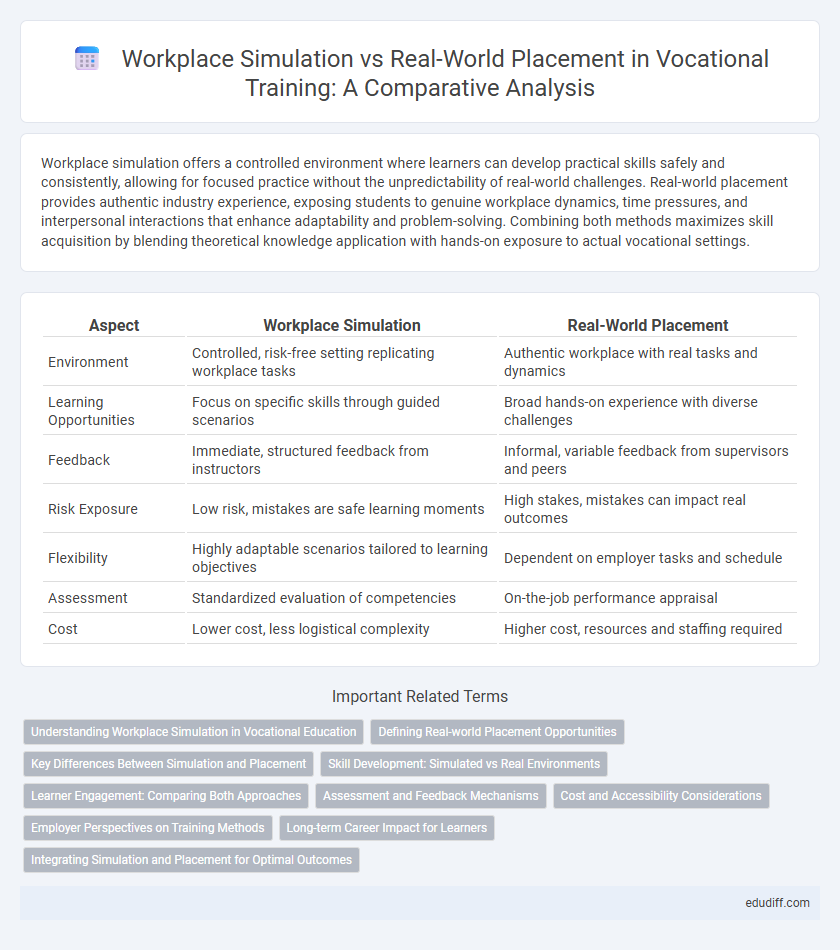Workplace simulation offers a controlled environment where learners can develop practical skills safely and consistently, allowing for focused practice without the unpredictability of real-world challenges. Real-world placement provides authentic industry experience, exposing students to genuine workplace dynamics, time pressures, and interpersonal interactions that enhance adaptability and problem-solving. Combining both methods maximizes skill acquisition by blending theoretical knowledge application with hands-on exposure to actual vocational settings.
Table of Comparison
| Aspect | Workplace Simulation | Real-World Placement |
|---|---|---|
| Environment | Controlled, risk-free setting replicating workplace tasks | Authentic workplace with real tasks and dynamics |
| Learning Opportunities | Focus on specific skills through guided scenarios | Broad hands-on experience with diverse challenges |
| Feedback | Immediate, structured feedback from instructors | Informal, variable feedback from supervisors and peers |
| Risk Exposure | Low risk, mistakes are safe learning moments | High stakes, mistakes can impact real outcomes |
| Flexibility | Highly adaptable scenarios tailored to learning objectives | Dependent on employer tasks and schedule |
| Assessment | Standardized evaluation of competencies | On-the-job performance appraisal |
| Cost | Lower cost, less logistical complexity | Higher cost, resources and staffing required |
Understanding Workplace Simulation in Vocational Education
Workplace simulations in vocational education provide controlled, risk-free environments that replicate real-world job scenarios using advanced technologies such as virtual reality and interactive software. These simulations enhance skill acquisition by allowing learners to practice tasks repeatedly while receiving immediate feedback, which is often not feasible in actual workplace placements due to operational constraints. Integrating workplace simulations with real-world placements optimizes competency development, ensuring students attain both theoretical knowledge and practical experience essential for industry readiness.
Defining Real-world Placement Opportunities
Real-world placement opportunities involve immersive work experiences where vocational students engage directly with industry tasks under professional supervision, enabling skill application in authentic settings. These placements offer exposure to workplace culture, real-time problem-solving, and networking with professionals, which enhances employability and career readiness. Real-world placements differ from workplace simulations by providing dynamic environments with unpredictable challenges, promoting adaptive learning and practical competence.
Key Differences Between Simulation and Placement
Workplace simulation offers a controlled environment tailored for skill development through realistic scenarios, while real-world placement immerses learners in actual job settings, providing hands-on experience with live workflows and organizational culture. Simulations allow repetitive practice without real-world consequences, enabling learners to refine decision-making and technical abilities before encountering genuine job pressures. Placement integrates interpersonal dynamics and real-time problem solving, fostering professional adaptability and networking that simulations cannot fully replicate.
Skill Development: Simulated vs Real Environments
Workplace simulation offers controlled scenarios that enable focused practice of specific skills, enhancing competency in a safe environment with immediate feedback. Real-world placements expose learners to unpredictable tasks and social interactions, promoting adaptability, problem-solving, and practical experience under authentic conditions. Both methods complement each other in vocational training by balancing skill refinement through repetition and the development of real-time decision-making abilities.
Learner Engagement: Comparing Both Approaches
Workplace simulation enhances learner engagement by providing a controlled environment where trainees can practice skills repeatedly without real-world consequences, leading to increased confidence and competence. Real-world placements immerse learners in authentic work settings, fostering problem-solving and adaptability through direct interaction with workplace challenges. Balancing simulation and placement maximizes engagement by combining safe skill development with experiential learning under actual conditions.
Assessment and Feedback Mechanisms
Workplace simulation offers controlled assessment environments with immediate, standardized feedback, enabling precise evaluation of specific vocational skills. Real-world placement provides authentic, dynamic contexts where feedback is often observational and reflective, capturing adaptability and interpersonal competencies. Combining both methods enhances comprehensive assessment by balancing objective metrics with real-world experiential insights.
Cost and Accessibility Considerations
Workplace simulation offers a cost-effective alternative to real-world placements by reducing expenses related to travel, supervision, and liability insurance while providing controlled, repeatable learning scenarios. Accessibility is enhanced in simulated environments, allowing learners to engage regardless of geographic location or scheduling constraints, which is particularly beneficial for remote or underserved populations. However, real-world placements provide irreplaceable hands-on experience and networking opportunities despite higher costs and logistical challenges.
Employer Perspectives on Training Methods
Employers value workplace simulation for its ability to safely replicate real-world scenarios and enhance specific skill development without operational risks. Real-world placement remains essential for exposing trainees to authentic business environments, fostering adaptability and direct client interaction. Combining simulation with practical experience maximizes training effectiveness by aligning hands-on skill acquisition with actual workplace demands.
Long-term Career Impact for Learners
Workplace simulation provides controlled environments where learners can develop skills and receive immediate feedback, enhancing competency without the risks associated with real-world errors. Real-world placement offers authentic experiences that build adaptability, problem-solving abilities, and professional networks essential for long-term career growth. Combining both methods maximizes skill acquisition and confidence, leading to higher employability and sustained career advancement.
Integrating Simulation and Placement for Optimal Outcomes
Integrating workplace simulation with real-world placement enhances vocational training by combining controlled skill development with practical experience, leading to improved competency and confidence. Simulation provides a safe environment for learners to practice critical tasks and decision-making before transitioning to actual workplace settings, reducing errors and enhancing readiness. Blending both approaches ensures a comprehensive learning pathway that aligns theoretical knowledge with authentic job demands, maximizing learner outcomes and employer satisfaction.
Workplace simulation vs Real-world placement Infographic

 edudiff.com
edudiff.com